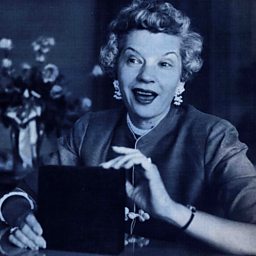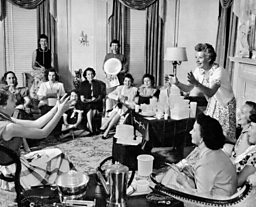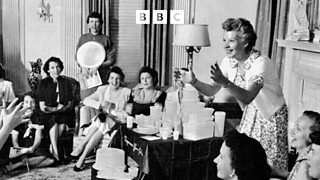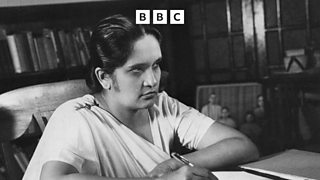The Tupperware party founder and her five steps to success
Brownie Wise was the single mum who pioneered the art of selling small, plastic food containers at parties in 1950s' America.
The so-called Tupperware parties she made popular were the forerunner of today’s direct selling parties.
The methods she used turned the Tupperware brand of food storage containers into a massive brand recognised all over the world.
They also made her a superstar – the first woman ever to make the front page of the influential Business Week magazine (below).
Here are five takeaway lessons from Brownie’s path to success:

1) Believe in yourself
An early career move for Brownie was a job demonstrating mops and cleaning products for a company called Stanley ±«Óătv Products.
Honey, management's no place for a woman"
But any hopes she had of moving up the Stanley ladder were quickly quashed, as Bob Kealing, author of Life of the Party, told the ±«Óătv's Witness History.
"The head of Stanley basically threw cold water on her ambition to be a manager," says Bob.
"Words to the effect of: 'Honey, management's no place for a woman.'
"Brownie's son Jerry told me about how angry she was and said: 'I'll show him!'"
2) Be bold
She left Stanley – and that’s when she really hit the big time.
On her own initiative, she started hosting parties to sell Tupperware.
By 1949, she was outselling the department stores in her home city of Detroit and had 19 demonstrators working for her.
But she started to get frustrated because she couldn’t get hold of enough Tupperware keep her going.
So she called up the founder of Tupperware, Earl Tupper himself, to give him an earful.
"You didn't normally talk to a guy like Earl Tupper that way,” says Bob.
Her audacious tone impressed him.
Tupper appointed Brownie as general sales manager of the new Tupperware ±«Óătv Parties Inc, the distribution wing for his 'baby'.
3) Have a gimmick

Her party trick was to fill a 'wonderbowl' - Tupperware's flagship product - with grape juice, seal it up very tight and then hurl it across the room.
"As you can imagine, people would be aghast," says Bob. "But it would fall and it would tumble across the floor and not a drop would would spill."
The success of her parties made her guests want to host their own.
By the time Brownie made the cover of Business Week in 1954, she had a network of 20,000 sellers hosting Tupperware parties.
4) Motivate your salesforce
"Brownie would offer the dress off her back as a prize for the best-selling dealer," says Bob.
The magazines and the TV networks are just eating this up"
"Women would lose 20 or 30 pounds (between 9-13kg) so they could fit into the dress."
There were plenty more giveaways to be had for Tupperware’s top demonstrators. These were awarded at the company’s annual jubilee at its headquarters in Florida.
"In 1956 at the jubilee, they actually buried a bunch of gifts and then they led their high performing dealers out to where all these gold shovels were in the ground and encouraged them to dig for treasure," says Bob.
"Faye of Buffalo, New York, finds this little model car. And then, of course, they lead her over to the new car that she's just won. And there's this great footage of her where she's hugging the hood of the car, saying that she loves everyone. And, of course, the magazines and the TV networks are just eating this up."
5) Don’t upset the boss
(OK, so this is a lesson that Brownie herself didn’t actually learn – but you can bet she wished she had!)
"Earl Tupper started to resent the fact that, according to some of the publicity, all of the success was Brownie, Brownie, Brownie.
"And he started feeling like her eye was off the ball and it was more about her than his baby, his product. Then things really started to go south," says Bob.
Tupper fired Brownie in 1958 – and she never managed to repeat the success she’d had at Tupperware.
To find out more about the rise and fall of Tupperware queen Brownie Wise, listen to Witness History.
More pioneering women from history
-
![]()
Rosalind Franklin: DNA pioneer
In 1951, young British scientist Rosalind Franklin produced an X-ray photograph that helped show the structure of DNA
-
![]()
The real-life 'Lady Tarzan'
In the early 2000s, Jamuna Tudu fought India's so-called timber mafia
-
![]()
Mary Quant and the miniskirt
The artist who changed fashion in the 1960s
-
![]()
The world's first woman premier
Sirimavo Bandaranaike was elected the prime minster of Sri Lanka in 1960 following the assassination of her husband





